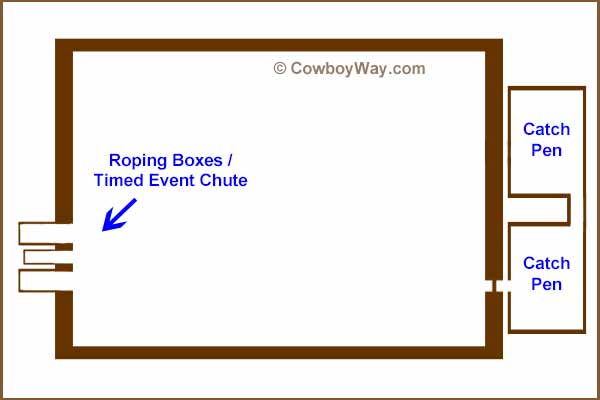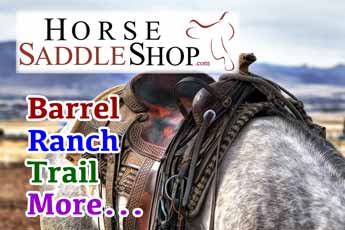What Are The Rodeo Catch Pens?
The "catch pens" at a rodeo arena are used to hold (or "catch") the calves and steers after they have finished their run in the arena.
As we mentioned above, the catch pens hold the calves and steers used in tie down roping, team roping, steer wrestling, and other events after they've completed their run in the arena.
The catch pens are always located at the opposite end of the arena from the timed event chute. If you're not familiar with the timed event chute, it is the livestock chute located between the two roping boxes.
If that didn't clear things up much, this might help:
- The roping boxes are where tie down ropers, team ropers, steer wrestlers, and some other contestants begin their run. They're typically called "roping" boxes even though they are also used by contestants who are competing in non-roping events, such as steer wrestlers.
- Between the two roping boxes is the timed event chute. It holds the calf or steer until it's released into the arena. The timed event chute is sometimes also called the "roping" chute even though it also holds livestock for events that don't involve roping, such as steer wresting.
Like we mentioned above, the catch pens are located on the opposite end of the arena from the timed event chute.
Below: A simplified drawing of a rodeo arena. While the illustration is basic and leaves out a lot of information, its purpose is to show that the catch pens are on the opposite end of the arena from the timed event chute. (This drawing shows two catch pens, but the number and design can vary.)

After leaving the timed event chute and running down the arena, the calves and steers always use the gates that lead into the catch pens to exit the arena.
Rodeo stock contractors want their timed event stock to perform its best, and allowing the calves and steers to only exit into the catch pens is very important in helping them perform well.
You might like these items. Or, Article continues below.
Why The Location Of The Catch Pens Matters
To understand why the location of the catch pens is so important, it's helpful to keep in mind that, in rodeo, it is a constant challenge to keep the conditions under which contestants compete as uniform as possible.
For timed event contestants that follow calves or steers down the arena, one of those challenges includes encouraging the calves and steers to run in a straight line so that each contestant can have a similar run.
For example, if one contestant were to draw a calf or steer that zigzagged, or one that took a hard turn halfway down the arena, and still others drew livestock that ran straight, the contestants that drew the straight-running critters would have better odds (usually, at least) of having a fast run.
So, in an attempt to help make the runs uniform, stock contractors and contestants both want the calves and steers to run straight down the arena.
And that's where the location of the catch pens comes in. Since the calves and steers know where the gates to the catch pens are, and they know these are the gates they use to exit the arena, they are more likely to run toward them than anyplace else.....
......and since the catch pens are located in a straight line down the arena from the timed event chute, the odds increase that the calves and steers will be happy to run in a straight line.....
......and that, of course, means increasing the odds of each contestant having the chance at a similar run.
Below: An illustration showing that the calves and steers are encouraged to run in a straight line because they know where the catch pens are.

Calves and Steers Know Where The Catch Pens Are Located
While not everyone realizes it, rodeo stock contractors put a significant amount of time into training their livestock: Broncs, bulls, calves, and steers alike. One of the things calves and steers are trained to know is the location of the catch pens.
If a calf or steer were to make a run then accidentally be allowed to exit through a gate other than the catch pen gates, they might learn to run for the different gate instead instead of the catch pens. A calf or steer like this is often difficult or impossible to retrain, and could be ruined for rodeo competition.
The Broncs and Bulls Have A Special Gate, Too
Like the calves and steers, the broncs and bulls have a special gate they use to exit the arena. It's called the "return gate," and, similar to the catch pen gates for calves and steers, its location is important to help broncs and bulls perform their best.
What Is / Are...
… What Are 5 Of The Biggest Wild West Robberies?
… What Are 5 Reasons Horse Trailer Lighting Matters?
… What Are 8 Dumb Things To Say To A Horse Lover?
… What Are 9 Proven Ways To Keep Flies Off Horses?
… What Are Chestnuts and Ergots?
… What Are The Parts Of A Western Saddle?
… What Are Saddle Rigging Positions?
… What Are Some Fencing Options?
… What Are Some Foods Both Horses And Dogs Can Eat?
… What Are Some Horse Fencing Basics?
… What Are Some Interesting Horse Facts?
… What Are Some Interesting Charts and Graphs With Horse Information?
… What Are Some Options For Temporary Horse Fencing?
… What Are Synthetic Saddles Made Of?
… What Are The Rodeo Catch Pens?
… What Are The 10 Best 3-Horse Trailers With Living Quarters In The USA And Canada?
… What Are The X's In A Cowboy Hat?
… What Are The Three Legal Head Catches?
… What Is The Angle System For Branding?
… What Is The Barrel Racing Pattern?
… What Is A Bull Riding Vest Made Of?
… What Is Deworming Your Horse?
… What Is A Domain Name?
Why would I need one for my farm or ranch even if I don't have or
want a website?
… What Is A Fifth Wheel Trailer Hitch?
… What Is Flag and National Anthem Etiquette At A Rodeo?
… What Is A Slant Load Horse Trailer?
… What Is Floating A Horse's Teeth?
… What Do Horse Freeze Brands Look Like?
… What Is A Galvayne's Groove?
… What Is A Gooseneck Trailer Hitch?
… What Is Some History About The First National Finals Rodeo?
… What Is The History Of The Modern, Hornless, Bronc Riding Saddle?
… What Is The History Of The Modern Rodeo Bucking Chute?
… What Is The History Of The One-Hand Bareback Rigging?
… What Is The Nasolacrimal Duct In Horses?
… What Is A Pony Express Mochila?
… What Is Hermann Oak Leather?
… What Is Larvicidal De-Worming?
… What Is The Flehmen Response?
… What Is The Rodeo Return Gate?
… What Is A Safety Tip For Posting The Colors?
… What Is A Slick Fork Saddle?
… What Is A Swell Fork Saddle?
You Might Also Like
